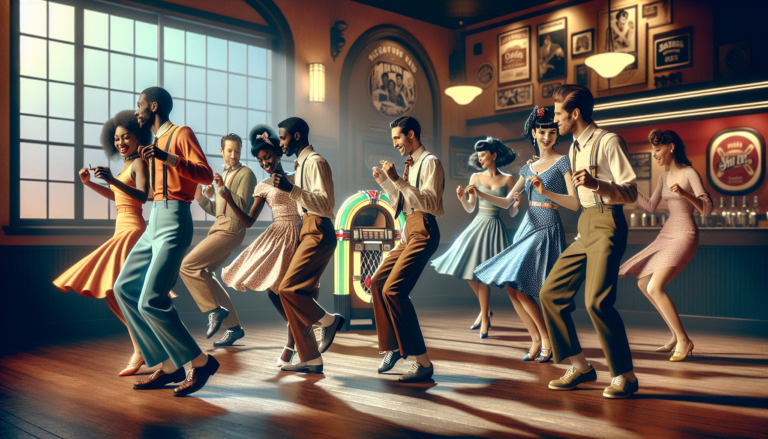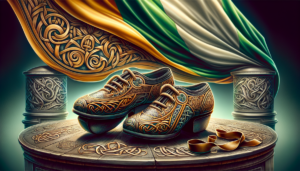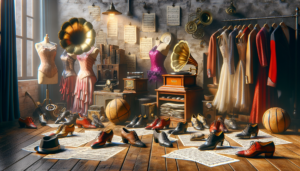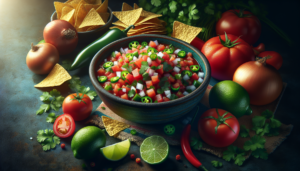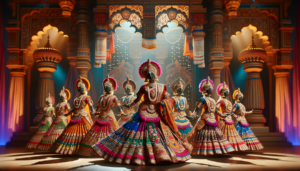Introduction to Jive Dance
Jive is a lively and energetic dance style that has captivated audiences for decades. Originating in the African American community in the early 20th century, jive dance has evolved into a global phenomenon, influencing music, fashion, and popular culture. With its fast-paced footwork, dynamic partner interactions, and upbeat rhythm, jive continues to be enjoyed by dancers of all ages and skill levels.
The rich history of jive is intertwined with the development of jazz music and the social changes that shaped the 20th century. From its roots in the dance halls of Harlem to its spread across the United States and Europe, jive has been a constant presence in the world of dance. Today, jive is celebrated in competitions, performances, and social dance events worldwide, a testament to its enduring appeal and the vibrant jive culture that surrounds it.
What is Jive?
Jive is a partner dance characterized by its fast-paced, syncopated rhythm and athletic movements. It is typically danced to swing music or rock and roll, with a tempo ranging from 176 to 208 beats per minute. Jive features a combination of six basic steps, performed in a compact and grounded style, with the knees slightly bent and the weight forward on the balls of the feet.
One of the defining elements of jive dance is the emphasis on improvisation and individual expression. While there are specific steps and patterns, dancers are encouraged to add their own flair and personality to the movements. This freedom of expression, combined with the lively music and social atmosphere, contributes to the infectious energy that makes jive so appealing.
The Origins of Jive
The origins of jive can be traced back to the African American community in the United States during the 1920s and 1930s. At this time, jazz music was gaining popularity, and dance halls in cities like Harlem, New York, became centers of social activity and artistic innovation. Dances like the Lindy Hop, Charleston, and Jitterbug emerged, blending African and European dance traditions with the syncopated rhythms of jazz.
As the music evolved, so did the dance styles. In the late 1930s, a new form of jazz known as swing began to dominate the dance halls. Swing music was characterized by a strong rhythm section, improvised solos, and a driving beat that encouraged fast, energetic dancing. It was against this backdrop that jive first began to take shape, drawing influence from the earlier jazz dances while incorporating new steps and patterns.
The Evolution of Jive
Jive in the 1930s and 1940s
During the 1930s and 1940s, jive continued to evolve alongside the swing music scene. Dancers in Harlem’s Savoy Ballroom, often referred to as the “home of happy feet,” were at the forefront of this development. They created new steps and variations, pushing the boundaries of what was possible on the dance floor.
One of the most influential figures in the early history of jive was Frankie Manning, a dancer and choreographer who is credited with creating many of the aerial steps and throws that became a hallmark of the Lindy Hop. Manning’s innovations, along with the contributions of other pioneering dancers, laid the foundation for the jive we know today.
As the United States entered World War II, jive became increasingly popular among young people. Dance halls and USO clubs provided a much-needed outlet for social interaction and entertainment during the war years. American GIs stationed overseas also helped to spread jive to other countries, particularly in Europe, where it would later develop into distinct regional styles.
Post-War Jive and Its Global Spread
In the years following World War II, jive continued to gain popularity both in the United States and abroad. The rise of rock and roll music in the 1950s brought new energy to the dance, as young people embraced the rebellious spirit and driving rhythms of artists like Elvis Presley and Chuck Berry.
Meanwhile, in Europe, jive was taking on new forms and styles. In the United Kingdom, a version of jive known as “boogie-woogie” emerged, characterized by its fast, bouncy movements and emphasis on improvisation. This style would later evolve into the modern ballroom jive, which is now danced competitively around the world.
The global spread of jive was further accelerated by the rise of television and film. Movies like “Rock Around the Clock” (1956) and “Jailhouse Rock” (1957) featured jive dancing prominently, exposing audiences worldwide to the exciting and energetic style. As a result, jive became a truly international dance, with thriving scenes in countries as diverse as Japan, Australia, and South Africa.
Jive Music and Rhythm
Characteristics of Jive Music
Jive music is characterized by its fast tempo, syncopated rhythm, and strong backbeat. The music is typically in 4/4 time, with a tempo ranging from 176 to 208 beats per minute. This fast pace is what gives jive its energetic and lively feel, encouraging dancers to move quickly and with enthusiasm.
Another key element of jive music is the use of swing eighths, also known as “swung” notes. In this rhythmic pattern, the first eighth note is slightly longer than the second, creating a lilting, bouncy feel that is essential to the character of jive. This swing rhythm is often emphasized by the bass and drums, which provide a strong foundation for the other instruments and the dancers.
Jive music also features a prominent melody, usually played by horns or other lead instruments. These melodies are often catchy and memorable, with a mix of long and short notes that complement the underlying rhythm. Improvisation is another important aspect of jive music, with musicians often taking solos and riffing on the main themes of the song.
Influential Jive Musicians
Throughout the history of jive, countless musicians have contributed to the development and popularity of the style. Some of the most influential jive musicians include:
1. Louis Jordan: Known as the “King of the Jukebox,” Jordan was a saxophonist, singer, and bandleader whose energetic performances and catchy songs helped to popularize jive music in the 1940s. Hits like “Is You Is or Is You Ain’t My Baby” and “Choo Choo Ch’Boogie” became jive standards and influenced countless artists in the decades that followed.
2. Cab Calloway: A legendary bandleader and singer, Calloway was known for his flamboyant stage presence and his ability to engage audiences with his music and dance moves. His band, The Cab Calloway Orchestra, was one of the most popular of the swing era, and their performances helped to spread the jive across the United States.
3. Benny Goodman: Clarinetist and bandleader Benny Goodman was a central figure in the swing music scene of the 1930s and 1940s. His band’s performances at the Savoy Ballroom in Harlem helped to popularize jive dancing, and their recordings remain classic examples of the style.
4. Lionel Hampton: Vibraphonist, drummer, and bandleader Lionel Hampton was another key figure in the development of jive music. His energetic performances and innovative use of the vibraphone helped to shape the sound of jive and inspire dancers around the world.
These musicians, along with countless others, helped to create the sound and rhythm of jive, which continues to be enjoyed by dancers and music lovers around the world.
Jive Dance Steps and Techniques
Basic Jive Steps
Learning the basic steps of jive is essential for any dancer looking to master this lively and energetic style. The six basic steps of jive are:
1. The Chasse: This step involves a side-close-side movement, with the feet moving in a “one-and-two” rhythm. The chasse is used to travel across the dance floor and is often combined with other steps to create more complex patterns.
2. The Change Step: Also known as the “rock step,” this move involves stepping forward or backward with one foot, then rocking back onto the other foot. The change step is used to change direction or prepare for the next move.
3. The Kick Ball Change: This step is a quick, three-count movement that involves kicking one foot forward, then stepping back onto the ball of that foot, followed by a step with the other foot. The kick ball change is a common ending to many jive patterns.
4. The Link: The link is a connecting step that is used to transition between other steps or patterns. It involves a small step forward or backward, followed by a closing of the feet.
5. The Whip: This step is a turning movement that involves spinning the follower out and then back in again. The whip is a classic jive move that adds excitement and flair to the dance.
6. The American Spin: Similar to the whip, the American spin involves spinning the follower out and then back in, but with a double turn instead of a single turn. This move requires good timing and coordination between partners.
By mastering these basic jive steps, dancers can begin to create their own combinations and patterns, adding their personal style and flair to the dance.
Advanced Jive Techniques
Once dancers have a solid foundation in the basic steps of jive, they can start to explore more advanced techniques and variations. Some of these advanced jive moves include:
1. The Catapult: This move involves the leader “launching” the follower forward and then catching them on the return. The catapult requires good timing, balance, and trust between partners.
2. The Windmill: In this move, the leader and follower connect hands and rotate around each other, creating a windmill-like effect. The windmill is a visually impressive move that requires coordination and spatial awareness.
3. The Shoulder Spin: This variation on the basic spin involves the follower spinning on the leader’s shoulder, creating a fast and dynamic movement. The shoulder spin is a crowd-pleasing move that showcases the athleticism and skill of the dancers.
4. The Toe Heel Swivels: These quick, pivoting steps are used to add rhythm and style to the dance. Toe heel swivels involve alternating between the toe and heel of the foot, creating a swiveling motion that complements the music.
5. The Slide: The slide is a traveling step that involves sliding the foot along the floor, either forward or backward. Slides can be used to cover distance quickly or to add a smooth, gliding quality to the dance.
By incorporating these and other advanced jive techniques, dancers can create a more varied and expressive performance, showcasing their skills and creativity on the dance floor.
Jive Competitions and Performances
Major Jive Competitions
Jive is not only a social dance but also a competitive one, with jive competitions held around the world. Some of the most prestigious jive competitions include:
1. The World Jive Championship: Held annually in Blackpool, England, this competition attracts top jive dancers from around the globe. Competitors are judged on their technique, musicality, and overall performance, with the winners crowned as the world champions of jive.
2. The US Open Swing Dance Championship: This competition, held in Burbank, California, features a variety of swing dance styles, including jive. Dancers compete in different age and skill level categories, showcasing their talents for an enthusiastic audience.
3. The European Jive Championship: Hosted in various cities across Europe, this competition brings together the best jive dancers from the continent and beyond. With multiple rounds of competition and a high level of skill on display, the European Jive Championship is a must-see event for jive enthusiasts.
4. The International Jive Championship: This competition, held in Tokyo, Japan, highlights the global appeal of jive. Dancers from Asia, Europe, and the Americas come together to compete and celebrate their shared love of the dance.
These and other jive competitions provide a platform for dancers to showcase their skills, connect with other enthusiasts, and push the boundaries of what is possible in the world of jive dance.
Famous Jive Performers
Throughout the history of jive, countless dancers have left their mark on the style, inspiring and influencing generations of performers. Some of the most famous jive dancers include:
1. Frankie Manning: Often referred to as the “grandfather of lindy hop,” Manning was a pioneering dancer and choreographer who helped to shape the early development of jive. His innovative moves and infectious energy made him a legend in the dance world, and his legacy continues to inspire dancers today.
2. Norma Miller: Known as the “Queen of Swing,” Miller was a trailblazing dancer who performed with some of the biggest names in swing music, including Count Basie and Duke Ellington. Her dynamic style and powerful presence on the dance floor made her a role model for generations of female dancers.
3. Dean Collins: A contemporary of Frankie Manning, Collins was a master of the smooth, fluid style of jive that became popular in the 1940s. His graceful movements and impeccable timing made him a sought-after partner and teacher, and his influence can still be seen in modern jive dancing.
4. Jean Veloz: A pioneer of the Hollywood-style lindy hop, Veloz was a frequent performer in movies and television shows throughout the 1940s and 1950s. Her elegant, precise style and dazzling smile made her a favorite of audiences around the world.
These and other famous jive performers have helped to shape the dance and keep its spirit alive, inspiring new generations of dancers to embrace the joy and energy of jive.
Jive Fashion and Culture
Iconic Jive Fashion
Jive dance has always been closely associated with fashion, with dancers using their clothing and accessories to express their individual style and personality. Some of the most iconic jive fashion elements include:
1. Wide-legged trousers: For men, high-waisted, wide-legged trousers were a staple of the jive look. These pants allowed for maximum freedom of movement on the dance floor and were often paired with suspenders or a belt.
2. Circle skirts: Women’s jive fashion was characterized by full, circular skirts that flared out when spinning or twirling. These skirts, often made of lightweight fabrics like cotton or rayon, added a sense of movement and drama to the dance.
3. Saddle shoes: Both men and women favored saddle shoes, with their distinctive two-tone leather uppers and thick rubber soles. These shoes provided the necessary support and traction for the quick, energetic movements of jive.
4. Sweater vests: Knitted sweater vests were a popular choice for men, often worn over a collared shirt. These vests added a touch of warmth and style to the jive ensemble.
5. Snoods and flowers: Women often accessorized their jive outfits with snoods (a type of hair net) and fresh flowers worn in the hair. These feminine touches helped to complete the look and add a sense of glamour to the dance floor.
Today, jive fashion continues to evolve, with dancers incorporating modern elements while still paying homage to the classic styles of the past.
Cultural Impact of Jive
Jive dance has had a profound impact on popular culture, influencing music, fashion, and social attitudes throughout the 20th century and beyond. Some of the most significant cultural effects of jive include:
1. Breaking down racial barriers: Jive emerged at a time when racial segregation was still widespread in the United States. However, the dance halls and clubs where jive was performed became spaces where people of different races could come together and share their love of music and dance. This helped to break down barriers and promote a more inclusive society.
2. Empowering women: Jive dance provided opportunities for women to express themselves and assert their independence in a male-dominated society. Female jive dancers like Norma Miller and Jean Veloz became role models for young women, showing that they could be strong, confident, and successful on their own terms.
3. Influencing popular music: The syncopated rhythms and improvisational spirit of jive had a major impact on the development of popular music, from swing and jazz to rock and roll and beyond. Many of the most iconic musicians of the 20th century, from Louis Armstrong to Elvis Presley, drew inspiration from the energy and excitement of jive dance.
4. Promoting social interaction: Jive dance provided a way for people to connect and socialize in a fun, positive environment. The partner-based nature of the dance encouraged communication, cooperation, and physical contact between dancers, helping to build a sense of community and shared experience.
5. Inspiring new forms of expression: The creativity and innovation of jive dancers helped to push the boundaries of what was possible in dance, paving the way for new styles and forms of expression. From the acrobatic moves of the lindy hop to the smooth, fluid style of West Coast swing, jive has been a constant source of inspiration for dancers around the world.
Today, the cultural legacy of jive lives on, with dancers and enthusiasts around the world continuing to celebrate and promote this timeless art form.
Conclusion
Jive dance is a vibrant and enduring art form that has captured the hearts and imaginations of people around the world. From its origins in the African-American community to its global spread and enduring popularity, jive has been a constant presence in the world of dance for nearly a century.
Through its fast-paced, syncopated rhythms and dynamic partner interactions, jive embodies the joy, energy, and creativity of human movement. It is a dance that encourages self-expression, social connection, and physical excellence, challenging dancers to push themselves and explore new possibilities.
The history of jive is a story of innovation, perseverance, and cultural exchange. From the dance halls of Harlem to the competition stages of Europe and Asia, jive has evolved and adapted to new times and places, while always remaining true to its core values of creativity, individuality, and communal spirit.
As we look to the future, it is clear that jive dance will continue to thrive and evolve, inspiring new generations of dancers and enthusiasts around the world. Whether performed socially or competitively, jive offers a timeless expression of the human spirit, a celebration of music, movement, and the boundless potential of the human body. So let us all take to the dance floor and let the rhythm of jive carry us forward, into a brighter and more joyful future.
#ED#

